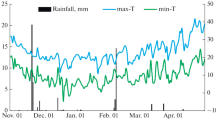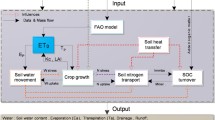Abstract
Evaluation of a field scale agricultural nonpoint source simulation model against field experiment data is an important step that must be considered before a model can be used as a management tool. Field soil water content and metribuzin residue adsorbed in soil profile were intensively monitored and measured by the gravimetric method and the LC-MS/MS method, respectively, for a soybean field plot located at the Asian Institute of Technology, Thailand. The Root Zone Water Quality Model (RZWQM) was evaluated based on laboratory-measured soil hydraulic properties and pesticide residue in Bangkok clay soil. Reasonable agreement exists between the soil water content measured and predicted by RZWQM for 10–20 and 30–40 cm soil depths. The model slightly overestimated the pesticide residue at 0–10 cm soil depth 1 day after application at surface, whereas pesticide residue at 10–20 and 30–40 cm soil depths was in agreement with model acceptance. These results indicate that RZWQM can be used when properly calibrated to predict the movement of water and metribuzin through the soil profile in the tropical zone.





Similar content being viewed by others
References
Ahuja, L., DeCoursey, D., Barnes, B., & Rojas, K. (1993). Characteristics of macropores studied with the ARS root zone water quality model. Transactions of ASAE, 36, 369–380.
Ahuja, L., Johnsen, K., & Heathman, G. (1995). Macropore transport of a surface applied bromide tracer: model evaluation and refinement. Soil Science Society of America Journal, 59, 1234–1241.
Ahuja, L. R., Ma, Q. L., Rojas, K. W., Boesten, J. J. T. I., & Farahani, H. J. (1996a). A field test of root zone water quality model—pesticide and bromide behavior. Pesticide Management Science, 48, 101–108.
Ahuja, L., Ma, L., Rojas, K., Boesten, J., & Farahani, H. (1996b). A field test of the RZWQM model for predicting pesticide and bromide behavior. Journal of Pesticide Science, 48, 101–108.
Ahuja, L. R., Rojas, K. W., Hanson, J. D., Shaffer, M. J., & Ma, L. (1999). Root zone water quality model: modeling management effects on water quality and crop production. Highlands Ranch: Water Resources Publications, LLC.
Ahuja, L. R., Rojas, K. W., Hanson, J. D., Shaffer, M. J., & Ma, L. (2000a). Root zone water quality model: modelling management effects on water quality and crop production. Highlands Ranch: Water Resources Publications, LLC.
Ahuja, L. R., Johnsen, K. E., & Rojas, K. W. (2000b). Water and chemical transport in soil matrix and macropores. In L. R. Ahuja, K. W. Rojas, J. D. Hanson, M. J. Shaffer, & L. Ma (Eds.), Root zone water quality model (pp. 13–50). Highland Ranch: Water Resources Publications.
Ahuja, L. R., Ma, L., & Green, T. R. (2010). Effective soil properties of heterogeneous areas for modeling infiltration and redistribution. Soil Science Society of America Journal, 74, 1469–1482.
Alves, I., & Cameira, M. R. (2002). Evapotranspiration estimation performance of root zone water quality model: evaluation and improvement. Agricultural Water Management, 57, 61–73.
Cameira, M. R., Sousa, P. L., Farahani, H. J., Ahuja, L. R., & Pereira, L. S. (1998). Evaluation of the RZWQM for the simulation of water and nitrate movement in level-basin, fertigated maize. Journal of Agricultural Engineering Research, 69(4), 331–341.
Cameira, M. R., Ahuja, L. R., Fernando, R. M., & Pereira, L. S. (2000). Evaluating field measured soil hydraulic properties in water transport simulations using the RZWQM. Journal of Hydrology, 236, 78–90.
Cameira, M. R., Fernando, R. M., Ahuja, L. R., & Ma, L. (2007). Using RZWQM to simulate the fate of nitrogen in field soil–crop environment in the Mediterranean region. Agricultural Water Management, 90, 121–136.
Carsel, R. F., Smith, C. M., Mulkey, L. A., Dean, J. D., & Jowise, P. P. (1984). User’s manual for the pesticide root zone model (PRZM), release 1. EPA-600/3-84-109. Athens: USEPA.
Cerejeira, M. J., Viana, P., Batista, S., Pereira, T., Silva, E., Valerio, M. J., et al. (2003). Pesticides in Portuguese surface and ground waters. Water Research, 37, 1055–1063.
Clemente, R. S. (2012). Land and water conservation and management. Bangkok: Asian Institute of Technology.
Ellerbroek, D. A., Durnford, D. S., & Loftis, J. C. (1998). Modeling pesticide transport in an irrigated field with variable water application and hydraulic conductivity. Journal of Environmental Quality, 27, 495–504.
Farahani, H. J., & Ahuja, L. (1996). Evapotranspiration modeling of partial canopy/residue covered fields. Transactions of ASAE, 39, 2051–2064.
Farahani, H. J., & DeCoursey, D. G. (2000). Evaporation and transpiration processes in the soil-residue canopy system. In L. R. Ahuja, K. W. Rojas, J. D. Hanson, M. J. Shaffer, & L. Ma (Eds.), The root zone water quality model (pp. 51–80). Highlands Ranch: Water Resources Publications LLC.
Farahani, H.J., Bausch, W.C., Aiken, R.M., & Ahuja, L.R. (1996). Evapotranspiration in system-wide agricultural models. In: Camp, C.R. (Ed.), Proceedings of the international conference on evapotranspiration and irrigation scheduling, San Antonio, Texas, 3–6 November, ASAE, MI, pp. 673–678.
Farahani, H. J., Buchleiter, G. W., Ahuja, L. R., & Sherrod, L. A. (1999). Model evaluation of dryland and irrigated cropping systems in Colorado. Agronomy Journal, 91, 212–219.
Ghidey, F., Alberts, E. E., & Kitchen, N. R. (1999). Evaluation of RZWQM using field measured data from the Missouri MSEA. Agronomy Journal, 91, 183–192.
Hedden, K. F. (1986). Example field testing of soil fate and transport model, PRZM, Dougherty Plain, Georgia. In S. C. Hern, & S. M. Melancon (Eds.), Vadose zone modeling of organic pollutants (pp. 81–101). Chelsea, MI: Lewis Publishers Inc.
Hendrickson, B. H., Barnett, A. P., Carreker, J. R., & Adams, W. E. (1963). Runoff and erosion control studies on Cecil soil in the southern Piedmont. USDA-ARS Technical Bulletin, 1281. U.S. Gov. Print. Office, Washington, D.C.
Jamsawang, P. (2009). Full scale test on Stiffened Deep Cement Mixing (SDCM) pile including 3D finite element simulation. (Doctoral Dissertation No.GE-09, Asian Institute of Technology), Bangkok, Thailand.
Jaynes, D. B., & Miller, G. J. (1999). Evaluation of RZWQM using field measured data from Iowa MSEA. Agronomy Journal, 91, 192–200.
Johnsen, K., Liu, H., Dane, J., Ahuja, L., & Workman, S. (1995). Simulating fluctuating water tables and tile drainage with the root zone water quality model and a new model WAFLOWM. Transactions of ASAE, 38, 75–83.
Jury, W., & Gardner, W. (1991). Soil physics. New York: John Willey & Sons Inc.
Karlsson, S. I. (2004). Agricultural pesticides in developing countries: a multilevel governance challenge. Environment, 46(4), 22–41.
Keen, A., Hall, N., Soni, P., Gholkar, M. D., Copper, S., & Ferdous, J. (2012). A review of the tractive performance of wheeled tractors and soil management in lowland intensive rice production. Journal of Terramechanics. doi:10.1016/j.jterra.2012.08.001.
Kumar, A., Kanwar, R. S., & Ahuja, L. R. (1998). Evaluation of preferential flow component of RZWQM in simulating water and atrazine transport to subsurface drains. Transactions of ASAE, 41(3):627–637.
Landa, F. M., Fausey, N. R., Nokes, S. E., & Hanson, J. D. (1999). Evaluation of the root zone water quality model (RZWQM3.2) at the Ohio MSEA. Agronomy Journal, 91, 220–227.
Leonard, R. A., Knisel, W. G., & Still, D. A. (1987). GLEAMS: groundwater loading effects of agricultural management systems. Transactions of ASAE, 30(5), 1403–1418.
Ma, Q. L., Ahuja, L. R., Rojas, K. W., Ferreira, V. F. & DeCoursey, D. G. (1995). Measured and RZWQM predicted atrazine dissipation and movement in a field soil. Transactions of ASAE, 38, 471–479.
Ma, L., Scott, H. D., Shaffer, M. J., & Ahuja, L. R. (1998a). RZWQM simulations of water and nitrate movement in a manured tall fescue field. Soil Science, 163, 259–270.
Ma, L., Shaffer, M., Boyd, B., Waskom, R., Ahuja, L., Rojas, K., et al. (1998b). Manure management in an irrigated silage corn field: experiment and modeling. Soil Science Society of America Journal, 62, 1006–1017.
Ma, L., Ahuja, L., Ascough, J., II, Shaffer, M., Rojas, K., Malone, R., et al. (2000). Integrating system modeling with field research in agriculture: applications of the root zone water quality model (RZWQM). Advances in Agronomy, 71, 233–293.
Ma, L., Nielsen, D. C., Ahuja, L. R., Malone, R. W., Saseendran, S. A., Rojas, K. W., et al. (2003). Evaluation of RZWQM under varying irrigation levels in Eastern Colorado. Transactions of ASAE, 46, 39–49.
Malone, R. W., Shipitalo, M. J., Ma, L., Ahuja, L. R., Rojas, K. W. (2001). Macropore component assessment of the Root Zone Water Quality Model (RZWQM) using no-till soil blocks. Transactions of ASAE, 44, 843–852.
Malone, R. W., Ahuja, L. R., Ma, L., Wauchope, R. D., Ma, Q., & Rojas, K. W. (2004). Application of the Root Zone Water Quality Model (RZWQM) to pesticide fate and transport: an overview. Pest Management Science, 60, 205–221.
Martin, D. L., & Watts, D. G. (1999). Application of the root zone water quality model in central Nebraska. Agronomy Journal, 91, 201–211.
Maru, S. (1991). Study on the behavior and fate of pesticides in aquatic environment. Spec. Bull. Chiba Agriculture Experimental Station, 18, 1–62 [In Japanese with English summary].
Matthews, G. A. (2008). Attitudes and behaviors regarding use of crop protection products—a survey of more than 8500 smallholders in 26 countries. Crop Protection, 27, 834–846.
Nokes, S. E., Landa, F. M., & Hanson, J. D. (1996). Evaluation of the crop component of the root zone water quality model for corn in Ohio. Transactions of ASAE, 39, 1177–1184.
Papadopoulou-Mourkidou, E., Karpouzas, D. G., Patsias, J., Kotopoulou, A., Milothridou, A., Kintzikoglou, K., et al. (2004). The potential of pesticides to contaminate the groundwater resources of the Axios river basin. Part II. Monitoring study in the south part of the basin. Science of Total Environment, 321(1–5), 147–164.
PCD (2012). Thailand state of pollution report 2011. Pollution Control Department (PCD), Thailand.
Readman, J. W., Albanis, T. A., Barcelo, D., Galassi, S., Tronczynski, J., & Gabrielides, G. P. (1993). Herbicide contamination of Mediterranean estuarine waters: results from a MED POL pilot survey. Marine Pollution Bulletin, 26, 613–619.
Rombke, J., Waichman, A. V., & Garcia, M. V. B. (2008). Risk assessment of pesticides for soils of the Central Amazon, Brazil: comparing outcomes with temperate and tropical data. Integrated Environmental Assessment and Management, 4, 94–104.
Sarkar, S. K., Bhattacharya, B. D., Bhattacharya, A., Chatterjee, M., Alam, A., Satpathy, K. K., et al. (2008). Occurrence, distribution and possible sources of organochlorine pesticide residues in tropical coastal environment of India: an overview. Environment International, 34, 1062–1071.
Saseendran, S. A., Nielsen, D. C., Lyon, D., Ma, L., Felter, D. G., Baltensperger, D. D., et al. (2009). Modeling responses of dry land spring triticale, proso millet, and foxtail millet to initial soil water in the High Plains. Field Crops Research, 113, 48–63.
Sinclair, T. R., & Seligman, N. G. (1996). Crop modelling: from infancy to maturity. Agronomy Journal, 88, 698–704.
Singh, P., Kanwar, R., Johnsen, K., & Ahuja, L. (1996). Calibration and evaluation of subsurface drainage component of RZWQM. Journal of Environmental Quality, 25, 56–63.
Skaggs, R.W. (1980). Methods for design and evaluation of drainage-water management systems for soils with high water tables. DRAINMOD Reference Report. Fort Worth, TEXAS: USDA-SCS South National Technical Center, Fort Worth, Texas 329.
Smith, R.E., & Ferreira, V., A. (1986). Effect of soil hydraulic properties on root zone transport processes. In Proc. 6th Annual AGU Front Range Branch Hydrology Days, 123–137. Ft. Collins, Colo.: Hydrology Days Publications.
Wu, L., Chen, W., Baker, J. M., & Lamb, J. A. (1999). Evaluation of RZWQM field measured data from a sandy soil. Agronomy Journal, 91, 177–182.
Acknowledgments
This work has been supported by the Center of Research for Environment, Energy and Water (CREEW), a research institute in Nepal. We would like to acknowledge the Water Engineering and Management (WEM), Agricultural Systems Engineering (ASE), Environmental Engineering and Management (EEM), Geotechnical and Earth Resources Engineering (GTE) field of study from AIT and Central Lab Thai of the Kasetsart University, Bangkok for laboratories facility and analysis. We are grateful to Pathumthani Agromet for providing meteorological data for this study.
Author information
Authors and Affiliations
Corresponding author
Rights and permissions
About this article
Cite this article
Shrestha, S., Manandhar, B. Evaluation of the Root Zone Water Quality Model (RZWQM) Using Field-Measured Data from the Tropical Zone, Thailand. Water Air Soil Pollut 225, 1958 (2014). https://doi.org/10.1007/s11270-014-1958-1
Received:
Accepted:
Published:
DOI: https://doi.org/10.1007/s11270-014-1958-1




